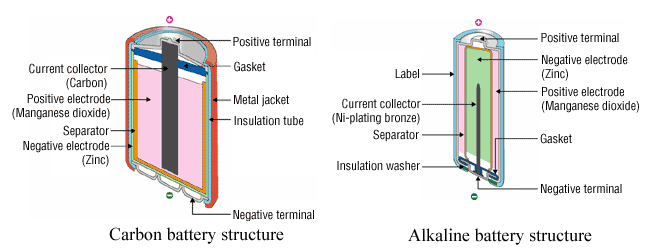The difference between carbon and alkaline batteries include,
a. In terms of material, both carbon battery and alkaline battery are dry batteries.
b. Carbon battery is carbon zinc battery, also called zinc manganese battery. It is a most common dry battery and features low price, high safety and reliable. Yet it contains heavy metal cadmium, which must be recycled for purpose of environmental protection.
c. Alkaline battery is alkaline dry battery or alkaline zinc manganese battery. This battery is applicable to high-current discharge and long-term work. It has low internal resistance, high discharge current and 0.025% mercury content. By virtue of environmental protection, alkaline batteries are more popular now.
d. Rated voltage of carbon battery and alkaline battery is 1.5V; but for the same model, alkaline battery has larger capacity, and is suitable to larger current discharge.
e. The essential difference between carbon battery and alkaline battery is internal material. In a word, carbon battery is composed of carbon rob and zinc case, and there are cadmium and mercury, not good for environment protection, but since it’s cheap, so it still has market share; alkaline battery is eco-friendly and represents a future trend of dry battery development.
Zinc manganese dry battery firstly came into battery market; its prototype, acid zinc manganese was developed by French George Leclanche in 1860, so it was also called Leclanche battery. Its case was zinc as anode pole and carbon sob as cathode with conductive material in the center. There were MnO2 and carbon powders around carbon sob in the cathode area, and pasty ZnCL2 and NH4 mixture in the anode area.
Alkaline zinc manganese battery started to come into market since 1950s. Recently, acid zinc carbon battery has gradually replaced by alkaline zinc manganese battery, whose electrolyte is KOH.
Alkaline battery structure is completely opposite to acid battery. It is made up of center anode, zinc powder, outside cathode with MnO2 and KOH and steel case. It overcomes disadvantage of acid Battery Storage and voltage unstable feature, but it is primary battery too.
Alkaline battery capacity is 4-5 times higher than that of carbon battery whereas its price is 1.5-2.0 times higher of that of carbon battery. Carbon battery is suitable for low current applications, such as quartz clock, remote control, radio etc.; alkaline battery is applicable to high current discharge, e.g. CD player, electric brush, electric toy and PDA.





